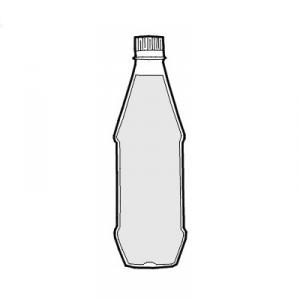Executive Summary
Sales and consumption of bottled water have skyrocketed in recent years. The global consumption of bottled water reached 230 billion litres in 2010 and was growing faster than 6% per year (ZENITHINTERNATIONAL 2011). Bottled water is here understood as packaged drinking-water (e.g. glass, plastic) in various sizes, from single servings to large carboys holding up to 80 litres. Small-scale water vendors are discussed in another factsheet. Bottled water costs around 1,000 times more per litre than high-quality municipal tap water. Why are consumers willing to pay this price? Maybe no other option exists (because of lacking supply, draught or any other environmental or political crisis) or tap water, if available, is simply perceived as non-drinkable (e.g. taste, colour, etc.). The bottled water industry is very dynamic: numerous bottled water companies compete on this market. But in all cases, it is less regulated than municipal water systems. Moreover, the bottling of water presents serious environmental and ethical challenges.
About Bottled Water
Adapted from FERRIER (2001)
Bottled water always looks the same. However, not all bottles contain the same product. Various types of bottled water can be identified, such as mineral water, spring water, purified water, sparkling water, well water, and artesian water. These types of bottled water can be divided into three main groups:
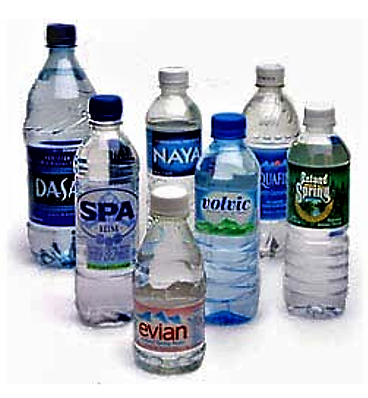
- Spring water is “water derived from an underground formation from which water flows naturally to the surface of the earth. Spring water must be collected only at the spring or through a borehole tapping the underground formation feeding the spring” (IBWA 2012).
- Mineral water is spring water with a constant concentration and relative proportions of mineral and trace elements at the point of emergence from the source (IBWA 2012). It is further characterised by its origin in an underground water table or deposit and emerging from a spring tapped at natural or bore exits. The best-known brands are Evian, Volvic, Perrier, San Pellegrino, etc. (FERRIER 2001).
- Purified water is water taken from rivers, lakes or underground aquifers (see also surface water sources and groundwater sources that has undergone some form of treatment. Those treatments can include sedimentation, coagulation flocculation, filtration (e.g. slow sand or rapid sand filtration), chlorination,ozonation, reverse osmosis, distillation, or deionisation (IBWA 2012). These processes are similar to what can be found in municipal drinking water treatment plants. Some companies also add some minerals (e.g. Nestlé's Pure Life, Coca-Cola's BonAquA).
Types of Packaging
Bottled water is most commonly sold in glass or disposable plastic bottles, like PET (polyethylene terephtalate) or PVC (vinyl polychlorure) (FERRIER 2001; WHO 2000). Bottled water also comes in various sizes from single servings to large carboys, which have volumes from approximately 0.1 – 80 litres.
All these materials have the potential for recycling, but only 29% of the PET bottles in the U.S. were recycled in 2010 (NAPCOR 2011). Moreover, the overwhelming majority of PET containers that are recycled do not become new bottles, but rather are downcycled for less valuable applications such as fleece, toys, or plastic lumber (ALUMINIUM 2012).
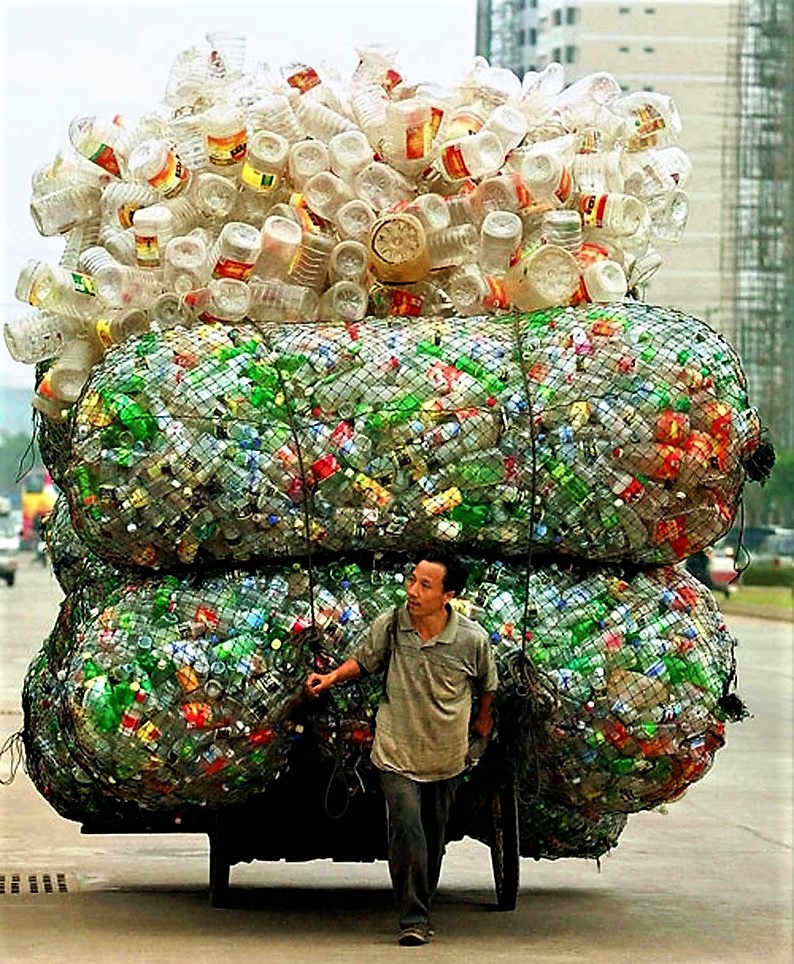
Bottled Water Use
The global consumption of bottled water reached 230 billion litres in 2010 and was growing faster than 6% per year. The highest growth rates are occurring in Asia and South America (ZENITHINTERNATIONAL 2011). Even in areas where tap water is safe to drink, demand for bottled water is increasing. The world’s leading consumer of bottled water consumers are the United States, closely followed by China (ZENITHINTERNATIONAL 2011).
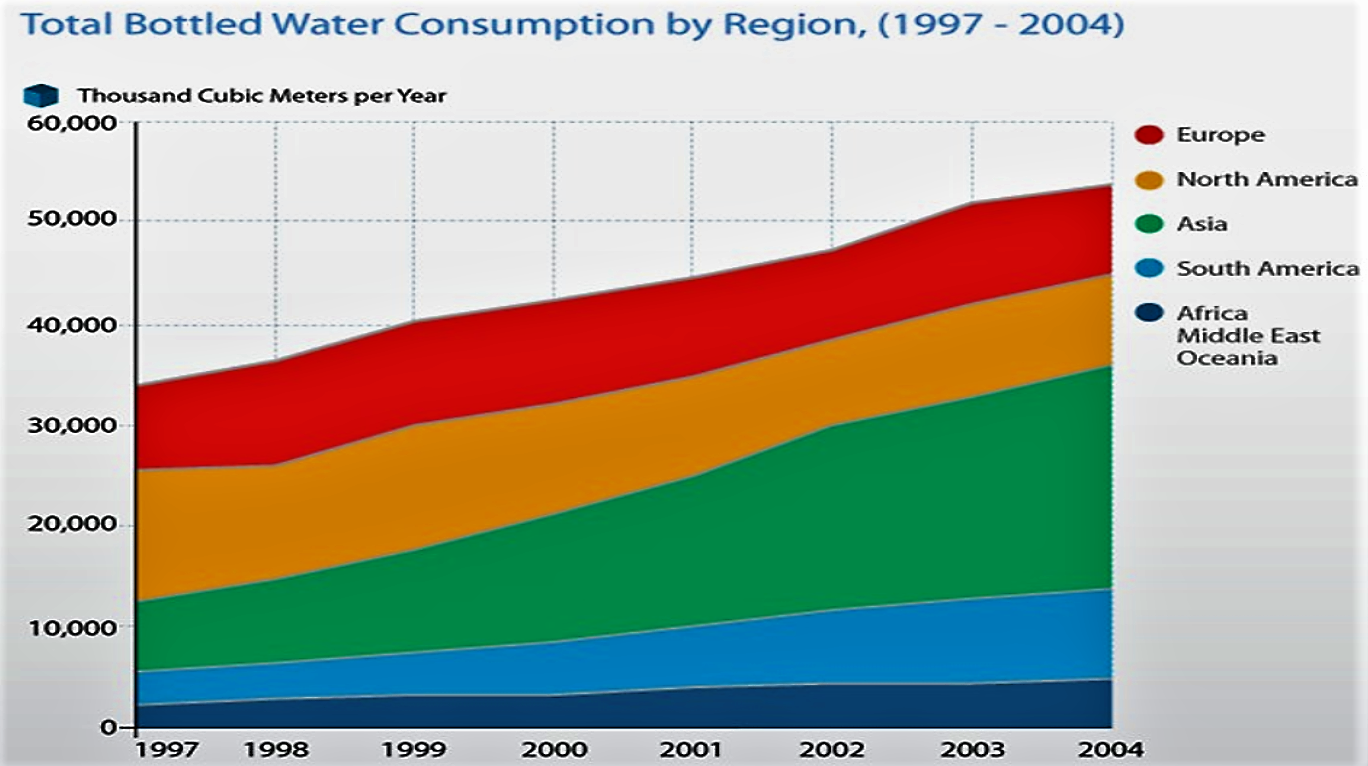
Consumers may have various reasons for purchasing bottled water: taste, convenience, lifestyle, mistrust of tap water, or potential health benefits. Although such considerations are often not founded on facts, the perception of bottled water to be healthier and tastier than tap water leads them to spend extra money. Meanwhile, in many developing countries, tap water is either (generally or temporarily) unavailable or unsafe, thus bottled water may provide a temporary and vital source of safe drinking water. In case of emergency situations (e.g. earthquakes, temporary flooding, temporary health risks) bottled water may be the only possibility as well.
Bottled Water Supply
The product cycle of bottled water from the source to the consumer has many steps :
- Pumping the water from a groundwater source or public water source and eventually further treating (see also the chapters groundwater sources and centralised treatments).
- Manufacturing plastic bottles.
- Bottling and further packaging.
- Distributing to supermarkets or shipping and eventually delivering to the customer's home.
- After consuming, the bottles are ready for reusing, recycling, downcycling or throwing away producing solid waste.
During this cycle, energy in used in a lot of different phases: to produce plastic and turn it into bottles, to treat the water, to fill and package the bottles, and finally to transport them. The energy needs of bottled water supply are largely to produce the plastic bottles (GLEICK & COOLEY 2009).
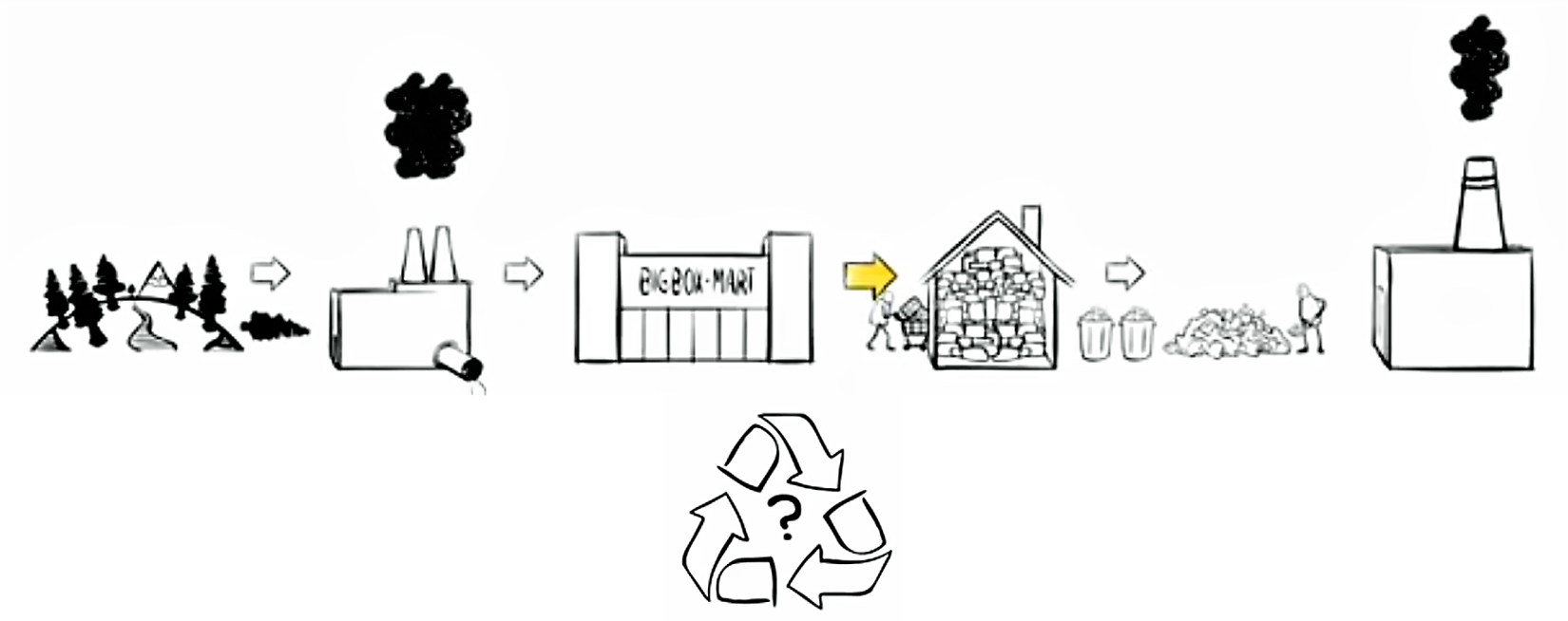
Bottled Water Industry
The bottled water industry is extremely prosperous, involving numerous companies. The world bottled water market is expected to reach US$65.9 billion by 2012 (PRWEB 2012). Although bottled water is a world market, with companies worldwide, 75% of it is still controlled by local actors (FERRIER 2001). Nestlé is number 1 on the world market of bottled water. Nestlé owns well-known brands in 38 countries, like Nestlé Pure Life, Perrier, San Pelegrino, etc. (NESTLE WATERS 2012). Danone comes first in Latin America and in the Asia-Pacific region. Its best-known brands are Evian, Volvic and Badoit.
Selling water is not only a big business for large companies but also for formal and informal small-scale water vendors. Water vendors are common in many parts of the world where water scarcity or lack of infrastructure limit access to drinking water, particularly in urban areas to reach the urban poor.
Health Aspects
“Bottled water quality is generally good, although it can suffer from the same contamination hazards as tap water” (FERRIER 2001). Generally, because bottled water is stored for longer periods and at higher temperatures than tap water, some micro-organisms that are normally of little or no health concern, may grow to high levels in bottled waters (WHO 2000).
Furthermore, bottled water quality control is less transparent and regulated than tap water. No universally accepted international standard certification scheme exists yet. “In some regions, consumers of bottled water can be assured of reliable and consistently high water quality. In others, no such assurances are possible” (GLEICK 2004).
Many consumers believe that natural mineral waters have medicinal properties or offer other health benefits. “Although certain mineral waters may be useful in providing essential micro-nutrients, such as calcium, WHO is unaware of any direct evidence to support the beneficial effects of consuming such mineral waters” (WHO 2000).
To read more about safely reusing bottles, see point of use water treatment methods like boiling, SODIS, WATASOL, chlorination, Household Water Treatment and Safe Storage, and safe storage.
Price & Costs
Adapted from GLEICK (2004)
Bottled water is hugely expensive compared to reliable high-quality municipal water supply (see figure below). In the long term, it is also more expensive then investing in a well maintained and robust point of use water treatment. Most of the cost is in the energy required in transportation and packaging. Bottled water is more expensive than petrol (GLEICK 2004). “Failure to provide municipal water supply often affects the poorest populations or peri-urban areas, leaving them to pay the inflated prices for water provides by private vendors or bottled water purveyors” (GLEICK 2004) (see also the factsheet about privatisation).
Overall, GLEICK (2004) estimates the total consumer expenditures for bottled water approach US$100 billion annually. This sum greatly exceeds the money that would be required to produce a comparable amount of water from reliable municipal systems. It also exceeds the estimated investment of US$11.3 billion annually to achieve the UN Millennium Development Goal related to access to water and sanitation by 2015 (NOTARAS 2009).
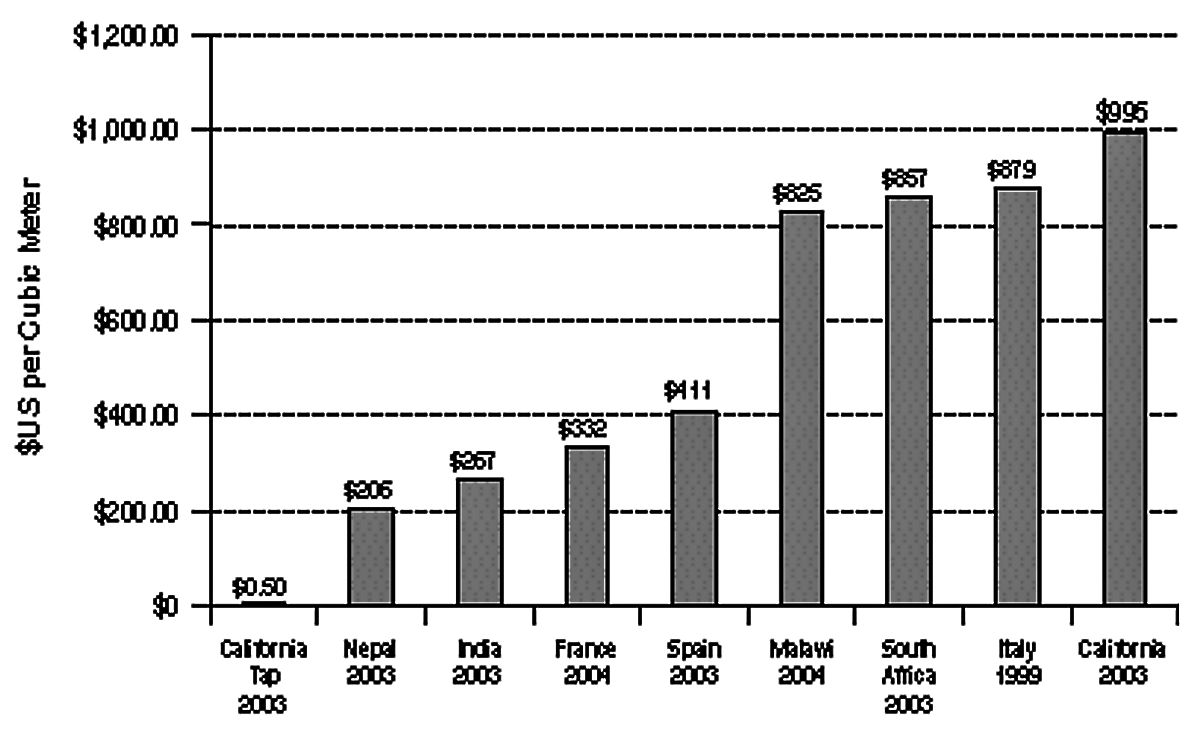
Environmental Issues: Energy, Waste & Waters
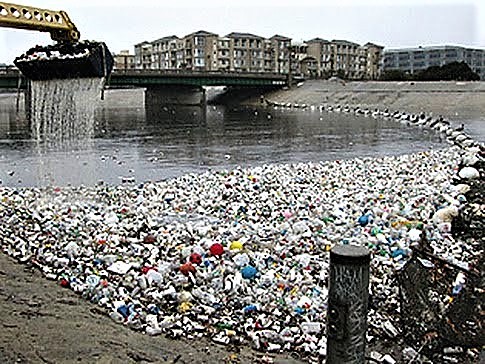
Some 2.7 million tons of plastic are used to produce bottled water worldwide (ANROLD & LARSEN 2006). Plastics are made from oil and natural gas, which are non-renewable resources. The processes to make plastics can cause serious pollution affecting both the environment and human health if left unregulated. Although PET requires less energy to recycle than glass or aluminium, and releases fewer emissions into the atmosphere, most plastic bottles are not being recycled: the recycling rate of PET in the U.S. was only 29% in 2011, thus more than 70% is not recycled (NAPCOR 2011). In countries where water supply infrastructures are not available, you can imagine that infrastructure to recycle PET bottles is unavailable as well. Since plastic degrades at a very slow rate, plastic bottles will remain a waste problem for up to 1,000 years (OWEN 2006).
Like other packaged drinks, bottled water contributes to climate change, mainly through the energy needs to produce plastic bottles and transportation. The PACIFIC INSTITUTE (2006) estimates that:
- Producing the bottles for American consumption in 2006 required more than 17 million barrels of oil, excluding transportation (PACIFIC INSTITUTE 2006). That is enough oil to fuel 1 million cars for a whole year (STORYOFSTUFF 2010).
- 1 ton of PET produces around 3 tons of CO2 a year (PACIFIC INSTITUTE 2006).
- It takes 3 litres of water to produce 1 litre of bottled water (PACIFIC INSTITUE 2006).
In addition, there are well-documented effects on other local waters. The lowering of ground water tables and over-extraction of local water supplies intrudes upon people’s livelihoods. Local villagers in India have, for example, blamed a Coca Cola bottled water plant for declining water levels and harm to local agriculture (NOTARAS 2009).
Ethical Challenges: Water and Sanitation as a Human Right
One of the most controversial aspects of the growing trend toward bottled water is about selling water to the poor. It is a fact that the populations most in need of improvements in municipal water systems, and hence most likely to need to use bottled water, are those least able to afford the high costs of bottled water. Some worry that increased bottled water sales to middle- and high-income dwellers will reduce pressures on governments for water infrastructure. In 1998, Nestlé launched a new initiative, Pure Life, to expand bottled water sales to the poorest consumers in Pakistan, Brazil, Argentina, Thailand, etc. (GLEICK 2004).
Even if bottled water in itself is not wrong, is water in itself a right? The 1977 Mar del Plata Action Plan from the United Nations Water Conference recognised water as a human right for the first time declaring “All peoples [...] have the right to have access to drinking water in quantities and of a quality equal to their basic needs” (NOTARAS 2009). See also the Millennium Development Goals. “Bottled water should not be considered a permanent alternative to reliable municipal supply for many reasons, including cost, control, and equity” (GLEICK 2004).
In the long term, bottled water is hugely expensive to consumers compared to reliable high-quality municipal water supply. Nevertheless, in the short term, bottled water may seem cheaper than a household filter or coal for boiling for very poor families. Bottled water is therefore only a temporary option where no other possibilities exist. For example, in regions where no such water infrastructure is available or safe, bottled water may provide a temporary and vital source of safe drinking water, also for mothers and their babies in the first months. During seasonal shortages and emergency situations, bottled water may be the only possibility as well. However, bottled water should no be considered a permanent alternative to municipal water supply.
Aluminum Takes On the Bottled Water Market
Bottled Water: Pouring Resources Down the Drain
How Much Is That Bottle of Water?
Bottled Water: Understanding a Social Phenomenon. Discussion Paper
This report, commissioned by WWF, is an independent documentation of research by the author. The objective of this discussion paper is to provide an overview of the bottled water market situation.
FERRIER, C. (2001): Bottled Water: Understanding a Social Phenomenon. Discussion Paper. Gland, Switzerland: WWF International URL [Accessed: 23.10.2012]The Myth and Reality of Bottled Water
This chapter reviews the recent history of and trends in bottled water, the regulations governing bottled water production and sale, and growing concerns about the costs and implications of bottled water use. It also addresses growing concerns in both industrialised nations where high-quality tap water is readily available and in poorer developing countries where the high cost of bottled water raises questions about equity and access to basic water services for all.
GLEICK, P.H. (2004): The Myth and Reality of Bottled Water. In: GLEICK, P.H. ; (2004): The World's Water. The Biennial Report on Freshwater Resources: 2004-2005. Washington, D.C.: . URL [Accessed: 08.04.2019]Bottled Water: An Update
Energy implications of bottled water
As bottled water use continues to expand around the world, there is growing interest in the environmental, economical, and social implications of that use, including concerns about waste generation, proper use of groundwater, hydrologic effects on local surface and groundwater, economic costs, and more. This paper estimates the energy footprint required for various phases of bottled water production, transportation, and use.
GLEICK, P.H. ; COOLEY, H.S. (2009): Energy implications of bottled water. In: Environmental Research Letters 4: Volume 4 , 1. URL [Accessed: 08.04.2019]Types of Water – Bottled
2011 Report on Postconsumer PET Container Recycling Activity
Bottled Water Isn't Healthier Than Tap, Report Reveals
From naïve to Evian
Bottled Water and Energy. A Pacific Institute Fact Sheet
Global Bottled Water Market to Reach $65.9 Billion by 2012, According to a New Report by Global Industry Analysts, Inc.
Bottled Water
This paper from the Safe Drinking Water Foundation (SDWF) in Canada, is a very informative source about how bottled water is regulated, whether bottled water is really safer than tap water and why we shouldn't drink bottled water.
SDWF (n.y): Bottled Water. Saskatoon, Canada: Safe Drinking Water Foundation (SDWF) URL [Accessed: 08.04.2019]The Story of Bottled Water
Bottled Drinking-Water. Factsheet N° 256
Evaluation of the costs and benefits of water and sanitation improvements at the global level
Global bottled water congress and market trends
The Hard Facts About Bottled Water
Bottled Water: Understanding a Social Phenomenon. Discussion Paper
This report, commissioned by WWF, is an independent documentation of research by the author. The objective of this discussion paper is to provide an overview of the bottled water market situation.
FERRIER, C. (2001): Bottled Water: Understanding a Social Phenomenon. Discussion Paper. Gland, Switzerland: WWF International URL [Accessed: 23.10.2012]The Myth and Reality of Bottled Water
This chapter reviews the recent history of and trends in bottled water, the regulations governing bottled water production and sale, and growing concerns about the costs and implications of bottled water use. It also addresses growing concerns in both industrialised nations where high-quality tap water is readily available and in poorer developing countries where the high cost of bottled water raises questions about equity and access to basic water services for all.
GLEICK, P.H. (2004): The Myth and Reality of Bottled Water. In: GLEICK, P.H. ; (2004): The World's Water. The Biennial Report on Freshwater Resources: 2004-2005. Washington, D.C.: . URL [Accessed: 08.04.2019]Energy implications of bottled water
As bottled water use continues to expand around the world, there is growing interest in the environmental, economical, and social implications of that use, including concerns about waste generation, proper use of groundwater, hydrologic effects on local surface and groundwater, economic costs, and more. This paper estimates the energy footprint required for various phases of bottled water production, transportation, and use.
GLEICK, P.H. ; COOLEY, H.S. (2009): Energy implications of bottled water. In: Environmental Research Letters 4: Volume 4 , 1. URL [Accessed: 08.04.2019]Bottled Water
This paper from the Safe Drinking Water Foundation (SDWF) in Canada, is a very informative source about how bottled water is regulated, whether bottled water is really safer than tap water and why we shouldn't drink bottled water.
SDWF (n.y): Bottled Water. Saskatoon, Canada: Safe Drinking Water Foundation (SDWF) URL [Accessed: 08.04.2019]The facts about bottled water
A nice and well-researched poster with the main facts about bottled water.
ONLINEEDUCATION (n.y): The facts about bottled water. Online Education Database URL [Accessed: 25.10.2012]Bottled Water Disaster
A slide show on the environmental disaster being caused by the use of bottled water. This presentation was authored by PM Architecture PC, Architects and Interior Designers, New York City.
PM ARCHITECTURE (n.y): Bottled Water Disaster. New York: PM Architecture URL [Accessed: 25.10.2012]Story of Bottled Water
The short film “Story of Bottled Water” (8 min.) is a very amusing and informative way to get into the issue of bottled water.
Bottled water - who needs it?
Another short film “Bottled water - who needs it?” (6:30 min.) from “The Open University”.
Bottled Water Archives - State of the Planet
The blog “State of the Planet” from the Earth Institute, Columbia University, New York, is a forum for discussion on varying viewpoints. Also on bottled water.
International Bottled Water Association (IBWA)
International Bottled Water Association (IBWA) unifies the bottled water industry and represents uncompromising commitment to the safety and availability of bottled water worldwide.
Creative and Cool Ways To Reuse Old Bottles
Some creative and cool ways to reuse old bottles.
WHO Media Center - Factsheets
Consumers may have various reasons for purchasing bottled drinking-water, such as taste, convenience or fashion, but for many consumers, safety and potential health benefits are important considerations. Since such considerations are often not founded on facts, these will be specifically addressed here.

